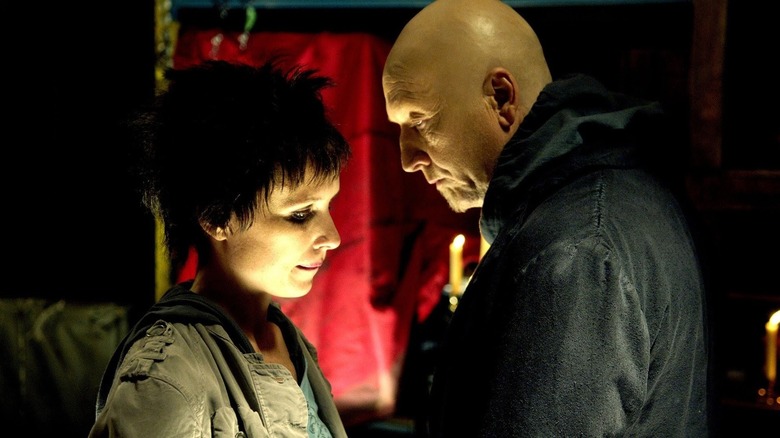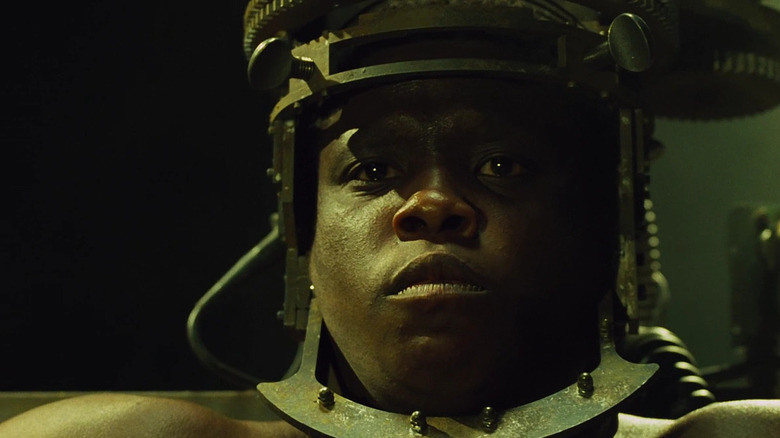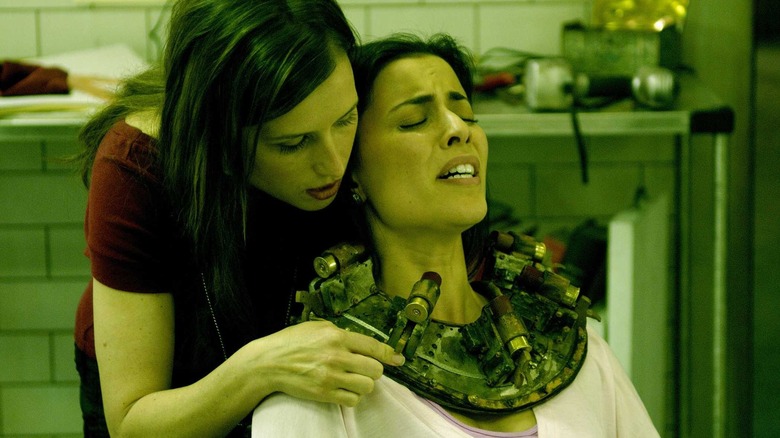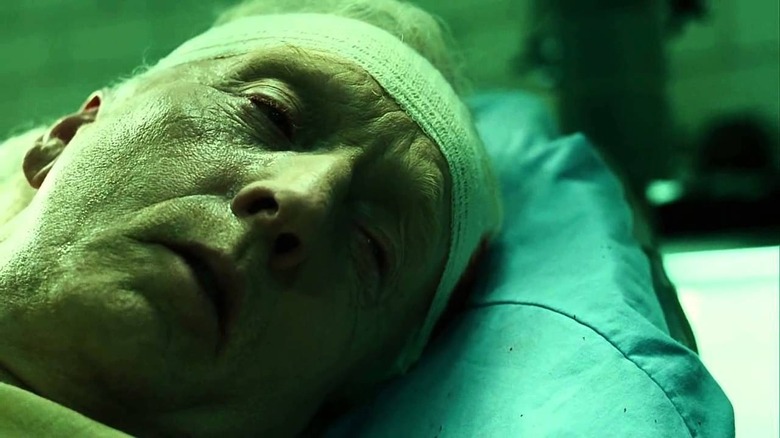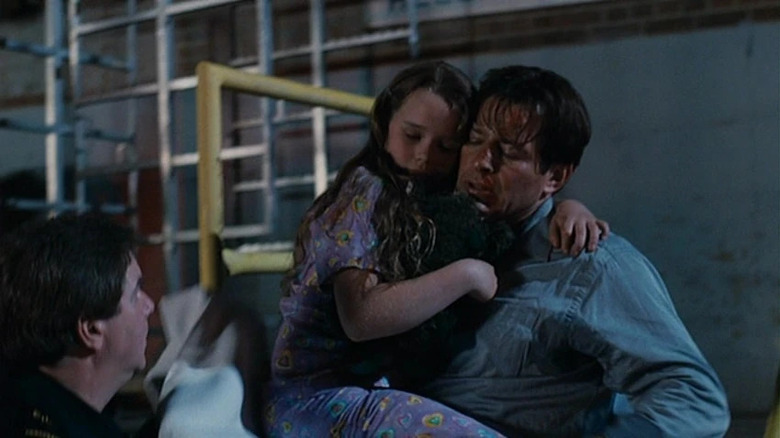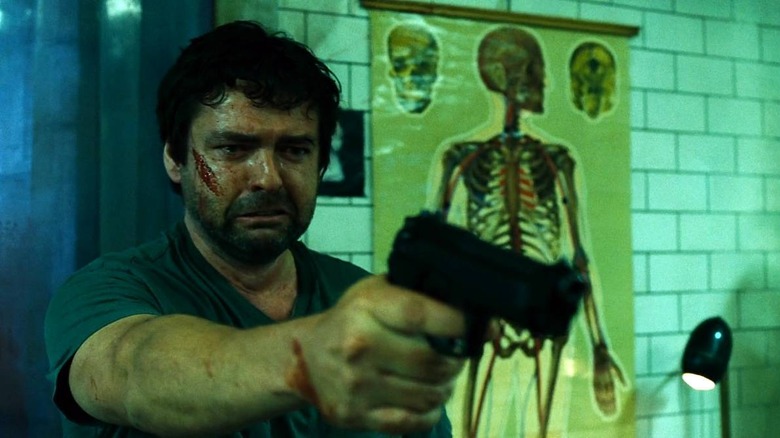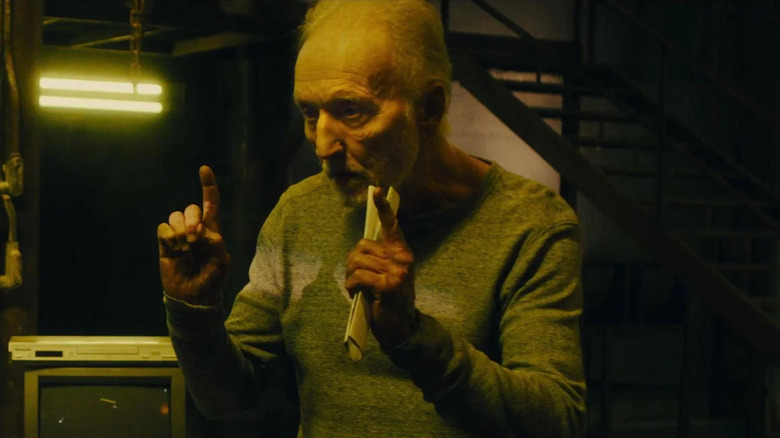Saw 3 Ending Explained: Carrying On The Jigsaw Legacy
"Saw III" raises the stakes from the previous two installments by focusing on John Kramer's deteriorating health. As his frontal lobe tumor worsens, John Kramer, aka Jigsaw, is left bedridden and weak, but he still has a few tricks up his sleeve. With the help of his beloved protege Amanda, he abducts Dr. Lynn Denlon.
Lynn must conduct a makeshift surgery to ease the pressure on his brain, and she wears a collar with five shotgun shells set to detonate if John's heart rate lowers or he dies. This intense operation, which involves removing a piece of his skull, is such a memorable part of "Saw III" — even more than the traps. It is fascinating to witness the medical marvel in such detailed close-ups.
"Saw III" stands out for its exceptional brutality compared to the first two "Saw" films. Not only does it ramp up the extremity of the violence and elaborate traps, but it also heightens the emotions by putting Jigsaw's health on the line and his paternal relationship with Amanda at the forefront. It is closer to "Saw X" in terms of dramatic tension, more of a father-daughter "love story" between John and Amanda, as Leigh Whannell told JoBlo, than a sadistic gorefest. "What Darren and I struck for 'Saw III' was to have an emotionally impactful ending," he explains on the DVD special features. "Saw III" succeeds at this on all levels, creating a high-stakes situation that is life or death for everyone, including Jigsaw himself.
What you need to remember about Saw III
True to its title, "Saw III" follows three narrative threads with a test for each character. The main victim of Jigsaw's latest game is Jeff Denlon, a grieving father who wants vengeance against the reckless driver who killed his son, Dylan, as well as against the lenient judge who let the driver off easy and a witness who refused to testify. As Jeff makes his way through the Gideon Meatpacking Plant, he comes across them all in savage traps. Can Jeff forgive them by saving their lives and letting go of his anger? Can he make peace with Dylan's death and appreciate his current life, such as his living daughter Corbett?
These new traps are especially vicious, including a freezer room that turns the human body into an icicle, a drowning in a vat filled with chopped-up pig parts, and the worst, The Rack, a device that slowly twists every part of the body — legs, arms, and even the neck — 360 degrees until it snaps.
Unbeknownst to Jeff, at the same time he undergoes his test, his wife Lynn is forced to provide Jigsaw medical treatment. She has her own personal troubles that make her a prime victim for one of Jigsaw's games: cheating on her husband Jeff, neglecting her daughter Corbett, and being careless in her work at the hospital. But the ending reveals that Lynn is just a small cog in a bigger machine that has been designed to test Amanda.
Throughout "Saw III," Amanda is extremely hostile towards Lynn. Overwhelmed by sadness and frustration, Amanda cannot cope with her mentor's physical decline. She continually directs her turbulent emotions towards the doctor, feeling angry with herself for not being able to help him the way Lynn can.
What happened at the end of Saw III?
"Saw III" ends tragically for all. While Jeff shows mercy to those involved with his son's deaths by valiantly attempting to rescue them — even burning his son's belongings in the process — he ultimately fails his test. As Jeff makes his way through the meatpacking plant, he enters a workshop where, lo and behold, he finds Jigsaw, Amanda, and his wife Lynn. Then everything comes crashing down like a house of cards.
Amanda shoots Lynn in the back and she falls in the arms of her husband, then Jeff shoots Amanda. We learn that Lynn was actually a part of Amanda's test. Jigsaw wanted to see if Amanda could keep her emotions in check and resist the urge to murder Lynn. Amanda's intense feelings have already been impacting her work as Jigsaw's apprentice. She manipulates traps, using them as a conduit for her own rage and dissatisfaction by making them impossible to survive — defying Jigsaw's philosophy that working hard for survival leads to enlightenment.
Jeff fails his test, too. Instead of forgiving Jigsaw for the pain he caused his family and allowing him to call an ambulance for Lynn, Jeff slashes his throat with a power saw, inevitably triggering Lynn's collar and causing it to detonate. Since he has not learned the virtue of compassion, Jigsaw's tape informs Jeff that his daughter Corbett will be left alone with dwindling oxygen and he will be left in this room to die.
Jigsaw is famous for getting a front-row seat to his twisted games but this was the ultimate performance: he literally places himself as a pawn whose fate is left to his players. Every character ultimately meets a tragic end, including the mastermind Jigsaw, who like many horror villains seemed invincible.
Grief is the most painful trap
The central theme of "Saw III" is how our emotions, particularly grief, can overcome us and drive us to do terrible things. While Jeff and Lynn are mourning the premature loss of their young son, Amanda is dealing with anticipatory grief of her cherished leader John Kramer. Caring for a terminally ill person is incredibly challenging. Every moment feels precious, yet fleeting at the same time. It's deeply upsetting to know that every minute with your loved one is counting down to the inevitable and quickly approaching end.
It's very painful for Amanda to witness someone who has, in her eyes, used their intelligence to change the world for the better, suffering from brain problems. This feeling of helplessness intensifies even when she has to interact with Lynn. Shawnee Smith expertly conveys Amanda's inner turmoil through her intense, shark-like expressions that also have a glint of vulnerability and sorrow.
It is equally devastating for John, in the last moments of his life, to realize that no one is able to pass his final test and Amanda has tarnished his Jigsaw legacy. Bosuman reflects on this idea in his interview with IGN:
"Imagine your entire life's work. You're on your deathbed. You know there's nothing else you can do and here's how you'll be remembered: as a killer, as a murderer. Not as someone who helped people."
This is what makes the ending of "Saw III" so heartbreaking.
Are there any unanswered questions?
In typical "Saw" fashion, the ending of "Saw III" leaves off with many questions. Since Jeff is sealed in the building, what will happen to his daughter Corbett? The answer isn't given until the next two films. During the "Saw IV" ending, which is revealed to take place during the events of "Saw III," we see Special Agent Peter Strahm searching the meat factory. He comes across Jeff Denlon and accidentally shoots him.
Detective Lieutenant Mark Hoffman, secretly Jigsaw's other apprentice, ends up imprisoning Strahm in the factory, allowing him to rescue Corbett from her cell in the factory "Saw V." This lets society view him as a hero, not a crooked cop secretly behind the very Jigsaw crimes he is investigating.
The subsequent films shed more light on what takes place in "Saw III." We learn more about Hoffman's contentious relationship with Amanda. Knowing that she would be tested by Jigsaw, Hoffman switched a letter in her desk, threatening to reveal her connection to Jill Tuck's miscarriage which took place during a drug run at the clinic with her then-boyfriend Cecil. The rest of the movies showcase Hoffman as an enigmatic character who is incredibly cold and calculating, unlike Amanda.
Alternate endings
"Saw III" comes in different versions: theatrical, Unrated, and Director's Cut. The Unrated edition is six minutes longer, and the Director's Cut is just over two hours, adding 12 additional minutes that include an extended ending.
The main difference between them, aside from the gore, is shuffling the order of the ending scene. The Director's Cut prolongs the finale's anguish by showing Jeff listening to Jigsaw's tape after he's murdered him, not during. In the theatrical version, everything moves so quickly that it feels like a freight train barreling off its rails. The tape plays as Jeff murders Jigsaw, so he hears the impact of what he's done as he's doing it.
The extended ending is far more quiet and unsettling. Jeff sits down next to his wife's mutilated head and holds her hand while listening to the tape with a deer-in-the-headlights stare. He's clearly in shock and seems to be in denial of his wife's death, still promising that he will get them both out of there.
The Unrated version ends with a devastating close-up of Lynn's head, now just a mangled mash of flesh, bone, and blood. The finality and gruesomeness of this image is a gut punch to the audience. It is far more impactful than the theatrical ending which only includes a brief glimpse of this disturbing shot.
Jigsaw forever
The death of Jigsaw, the central villain, is shocking and makes "Saw III" feel like such a monumental entry in the series. Yet filmmakers have been able to squeeze out lots more "Saw" sequels. In a recent IndieWire interview for "Saw X," which takes place between "Saw" and "Saw II," executive producer Mark Burg admits that Kramer's death is the one creative decision they'd like to have back:
"If I had to do it again, I might not have killed Tobin Bell in 'Saw III. That might have been a mistake."
Tobin Bell's pensive performance as the diabolical architect Jigsaw is truly the glue of this series. But "Saw III" swung for the fences and killed off their biggest character, causing filmmakers in the next installments to be more creative. The twists rely on timeline shifting and the impact of Jigsaw's legacy through apprentices and copycats while still incorporating Tobin Bell as John Kramer in flashbacks.
It's hard to imagine what would've happened to the franchise had he lived. "Saw X" proves that this universe greatly benefits from John Kramer's presence, and it will be interesting to see how they possibly move forward with Saw XI.
